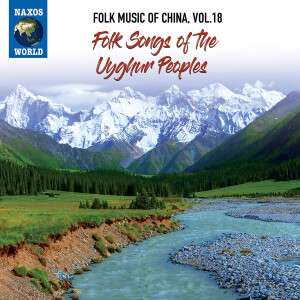 This album, the 18th volume in Naxos’ series of 20 releases covering the widely varied folk music of China, is immediately recognizable as something different from most of the other 20 albums. This one features folk songs of the Uyghur (WEE-goor) people, a Turkic ethnic group who are predominantly Muslim, living in the Xinjiang Uyghur Autonomous Region of northwestern China. The region borders Mongolia, Russia, Kazakhstan, Kyrgyzstan, Tajikistan, Afghanistan, Pakistan and India, and although the music incorporates some features of Chinese music, it’s closer to that of the other central and south Asian countries like Afghanistan.
This album, the 18th volume in Naxos’ series of 20 releases covering the widely varied folk music of China, is immediately recognizable as something different from most of the other 20 albums. This one features folk songs of the Uyghur (WEE-goor) people, a Turkic ethnic group who are predominantly Muslim, living in the Xinjiang Uyghur Autonomous Region of northwestern China. The region borders Mongolia, Russia, Kazakhstan, Kyrgyzstan, Tajikistan, Afghanistan, Pakistan and India, and although the music incorporates some features of Chinese music, it’s closer to that of the other central and south Asian countries like Afghanistan.
This album has fewer selections than most others in this series, with 13 tracks in total. Of those, six are folk songs from the Yili region in northern Xinjiang, and five are folk songs from Kashgar and Artux in southern Xinjiang. In addition to those are two longer excerpts from the Uyghur Twelve Muqam – a genre of classical music. (Muqam or maqam is a musical genre common in North Africa and parts of Asia, understood as “rules,” “modes” or “melodic formulas.”
All of these songs are performed by a solo male singer, accompanied by one of a couple of different kinds of lute and hand percussion. I’m betraying my own personal preferences a bit here, but I find the music on this album totally beguiling and fascinating. I’m much more familiar with the modes of music from the Middle East, North Africa, and Southern and Central Asia than I am with those from East Asia which comprise most of the other albums in this series. I guess I just connect with this music more readily, although I find the whole series and each individual disc interesting, at times captivating and frequently very exciting.
The six songs from the Yili region nearly flow together as a suite, as do the five selections from Kashgar region – the selections from each region all share a pretty similar rhythm and melody with each other, although obviously the subject matter of the lyrics differs for those who understand Uyghur. Songs from both regions range from topics in nature (“White Fish,” “White Steed,” and “My Sparrow Hawk” in Yili; “Mountains at the Yingjisha County” and “Pomegranates of Kashgar” in Kashgar) as well as love songs (“My Fair Lady,” “Black Eyes” – Yili; “My Charming Lover,” “My Lover,” – Kashgar).
To my ear the songs of Yili region incorporate a few more features of the Chinese music system, particularly in the way quarter tones are used, and the Kashgar songs tend to sound a bit more Persian influenced. The final folk song is from the Artux region and sounds quite different from the others, with a faster tempo, different rhythmic scheme and a vocal style that sounds closer to Arabic or North African.
The excerpts of the two muqams are both really excellent. The first, “Pänjigah Muqam,” features some lightning fast playing on the lute known as the Ili style of rewap, its five strings divided into three groups; the lightning picking with one low droning string gives a sound similar to a sitar in places. This track consists of two Dastan songs, its lyrics drawn from Uyghur poetry, plus a Mughul song.
The final track is an excerpt of “Özhal Muqam,” played on two other kinds of lute known as the tembor and dotar – both of which are plucked lutes popular in Central Asia and Iran. The tembor has a long neck with 26 frets. It has five strings divided into three groups: one main string and the other four grouped in pairs as accompanying strings. There are 17 frets on the neck of the Uyghur dotar, whose name is Persian for “two strings.” The singer uses a lot of sustained notes sung over the plucking of the lutes. The second section, which features both types of lute playing together behind the singer, is a highlight of the disc, as is the third and final section, a lengthy double lute instrumental that wraps up the program on a splendid note.
This album is a revelation. I hope to seek out more examples of Uyghur music, especially the Uyghur Twelve Muqam.
You can listen to excerpts of every song and learn much more about this music on the Naxos website.
(Naxos, 2021)
